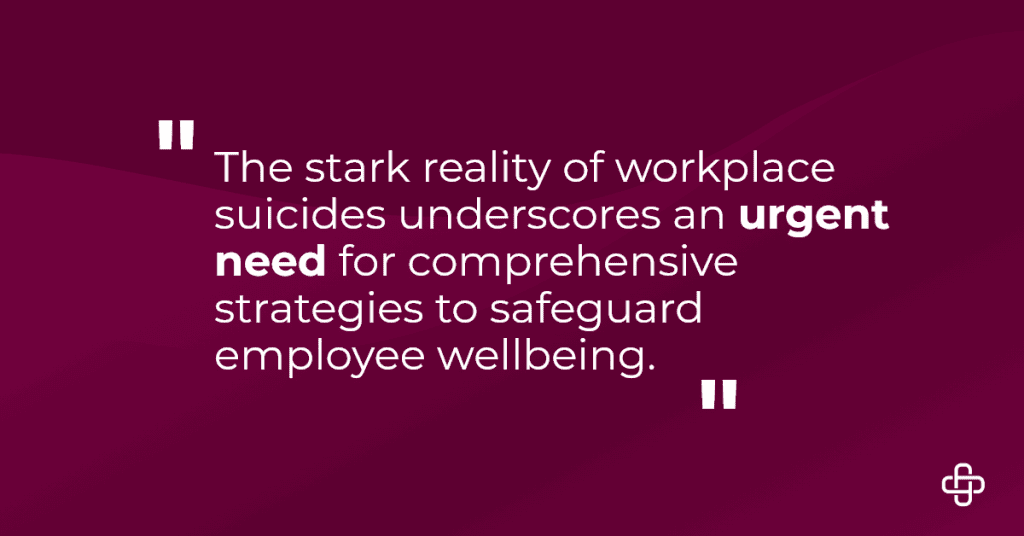How can we, as employers and colleagues, contribute to a culture that actively combats the stigma surrounding mental health and fosters an environment where asking for help is encouraged?
In fast-paced and often high-pressure work environments, mental health has catapulted to the forefront of critical workplace issues.
The stark reality of workplace suicides underscores an urgent need for comprehensive strategies to safeguard employee wellbeing.

Understanding the Problem
Recent statistics illuminate a concerning trend: the incidence of workplace suicides is on the rise, marking a pivotal call to action for organizations worldwide. Common risk factors include:
- overwhelming stress
- feelings of isolation
- lack of access to mental health resources
Recognizing warning signs, such as drastic changes in behavior, increased absenteeism, and verbal distress cues, is the first defense of prevention.
It is crucial to acknowledge that suicide prevention goes beyond identifying risk factors and requires a comprehensive approach involving all levels of the organization.
Building a Supportive Environment
Leadership is pivotal in cultivating a workplace where employees feel valued and supported.
An open-door policy and initiatives aimed at reducing the stigma surrounding mental health are crucial.
Encouraging open dialogue and demonstrating genuine empathy can significantly contribute to a culture where employees feel safe seeking help.
Suicide Prevention Training
Educating employees and managers about suicide prevention is essential.
Training programs should cover identifying warning signs, effective communication strategies, and how to guide at-risk individuals toward professional help.
Armed with knowledge and understanding, the workplace community becomes a powerful ally in suicide prevention efforts.
Establishing a Suicide Prevention Program
Implementing a structured suicide prevention program in the workplace is essential for addressing this critical issue. The following steps can help organizations develop an effective program:
- Conduct an Assessment: Begin by assessing the current state of mental health and well-being in the workplace. Survey employees to gain insights into their stress levels, work-life balance, access to mental health resources, and perceived support from managers.
- Train Management and Staff: Education is key to creating a supportive, informed workplace culture. Provide suicide prevention training to managers and employees to help them recognize warning signs and respond appropriately.
- Promote Employee Assistance Programs: Ensure employees are aware of any existing resources, such as an Employee Assistance Program (EAP), that can support mental health concerns.
- Create a Crisis Response Plan: Develop a clear and comprehensive plan for responding to a crisis or emergency involving suicidal behavior. This should include steps for de-escalation, contacting emergency services, and providing support for affected employees.
- Foster a Supportive Workplace Culture: Create an environment where employees feel comfortable discussing mental health concerns without fear of stigma or retribution. Encourage open communication and offer resources for self-care and stress management.
- Continuously Evaluate and Improve: Monitor the program’s effectiveness and adjust as needed to ensure it meets employees’ needs and addresses any gaps.
Individual Roles in Suicide Prevention Efforts
While organizations have a responsibility to implement suicide prevention programs, individuals also play a crucial role in creating a supportive and safe workplace.
Some ways employees can contribute include:
- Educate on mental health and suicide prevention to recognize and act on warning signs.
- Speak up to HR or management about concerning behaviors in colleagues.
- Support coworkers with empathy, offering help without judgment.
- Prioritize self-care, encouraging breaks, stress management, and using resources like an EAP.
Suicide prevention in the workplace requires a collaborative effort between organizations and individuals. By implementing a comprehensive prevention program, educating.
Legal and Ethical Responsibilities in Suicide Prevention
Employers bear a legal and ethical responsibility to foster a safe work environment that proactively supports mental health.
Navigating the complexities of privacy laws while implementing mental health support initiatives demands a delicate balance.
Organizations must understand their obligations and craft policies that respect employee privacy while offering essential support.
Resources and Support for Employees
Making mental health resources and support services readily available to employees is non-negotiable.
Employers should actively promote these resources, ensuring that all employees understand how to access help when needed.
From Employee Assistance Programs (EAPs) to external mental health services, a well-publicized suite of support options can be lifesaving.
Axiom Medical combines dual physical and mental health assessments through its injury case management services and offers its behavioral health solution, Tempo Live.
This innovative strategy recognizes the intertwined nature of physical injuries and mental health, enabling a holistic evaluation and intervention process.
By offering comprehensive health assessments that consider both physical and psychological aspects, Axiom Medical ensures that individuals receive a thorough analysis of their well-being, leading to more personalized and effective treatment plans.
Tempo Live further reinforces this by providing real-time, adaptable support designed to meet employees’ mental health needs promptly.
Conclusion
The imperative to integrate robust suicide prevention strategies into workplace health and safety protocols has never been more critical.
By taking decisive action, employers can significantly reduce the risk of workplace suicides and foster an environment where mental health is prioritized.
Suicide prevention is not just a policy—it’s a promise to look after one another in our most vulnerable moments.
Don’t miss out on the invaluable insights shared in the replay of “Breaking the Silence: Tools for Combating Workplace Despair & Suicide.” This session is a critical resource for anyone committed to changing the narrative around mental health in the workplace.
Axiom Medical invites you to continue this important conversation by watching for our next webinar in the mental health series, “Stress to Strengthened: Techniques for Managing Workplace Anxiety.”
Here, you will gain practical tools and strategies to transform workplace challenges into opportunities for resilience and well-being.
Watch the free webinar replay now to be a part of this essential movement towards positive change.
Charli Pedersen is a published writer featured on Axiom Medical’s blog. She holds a bachelor’s degree in English, Professional and Technical Writing, and has experience creating content for businesses and non-profit organizations.










